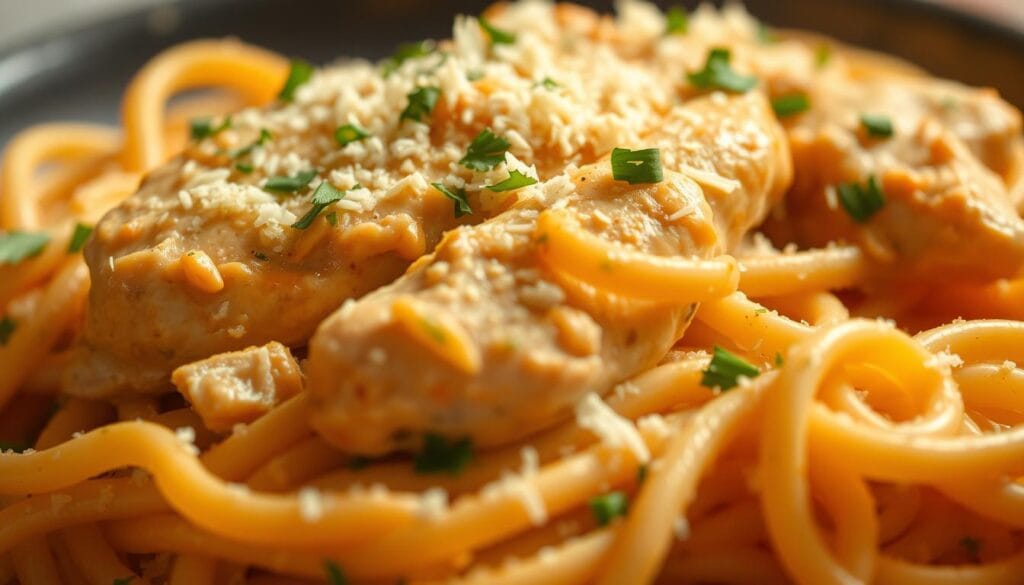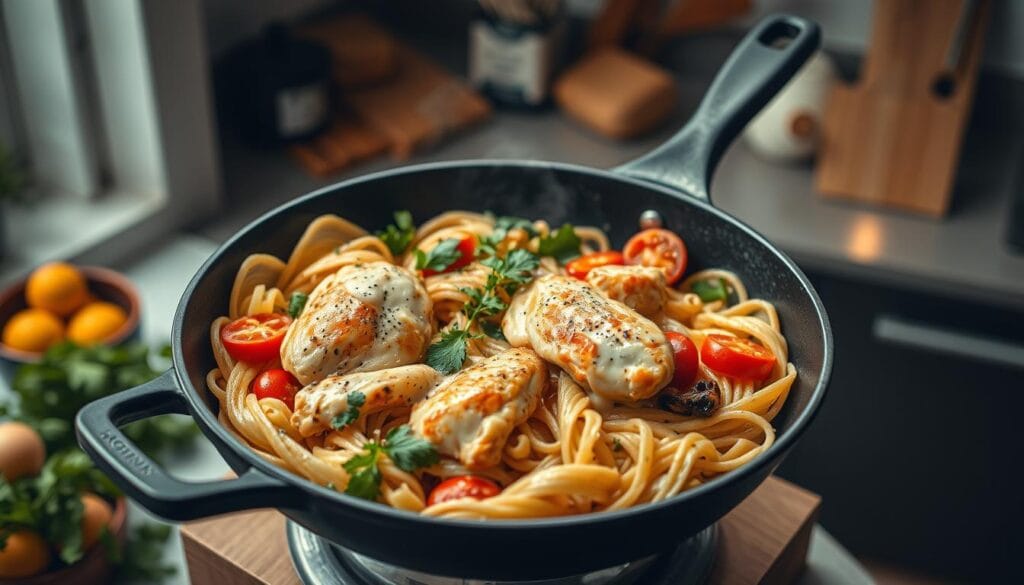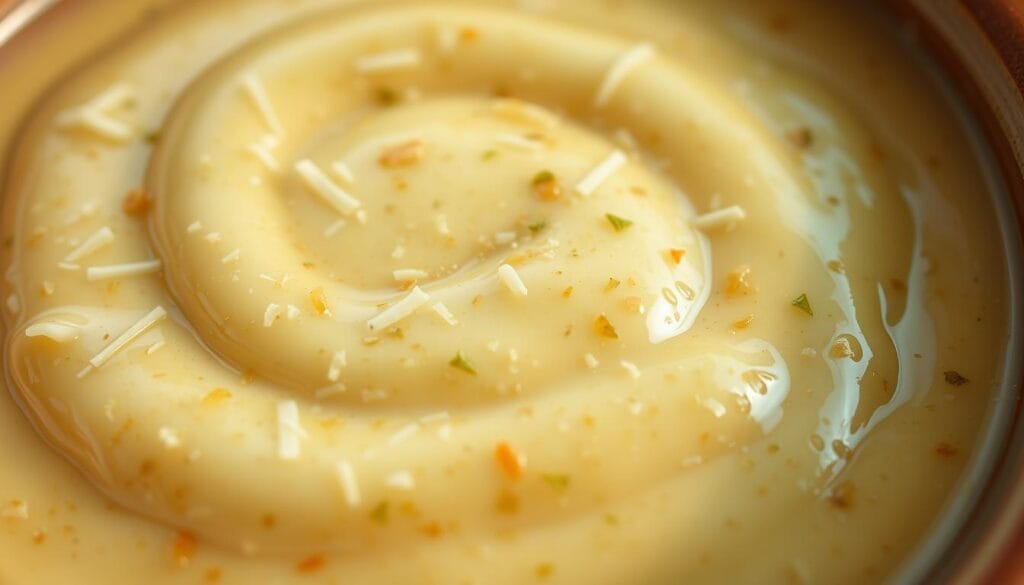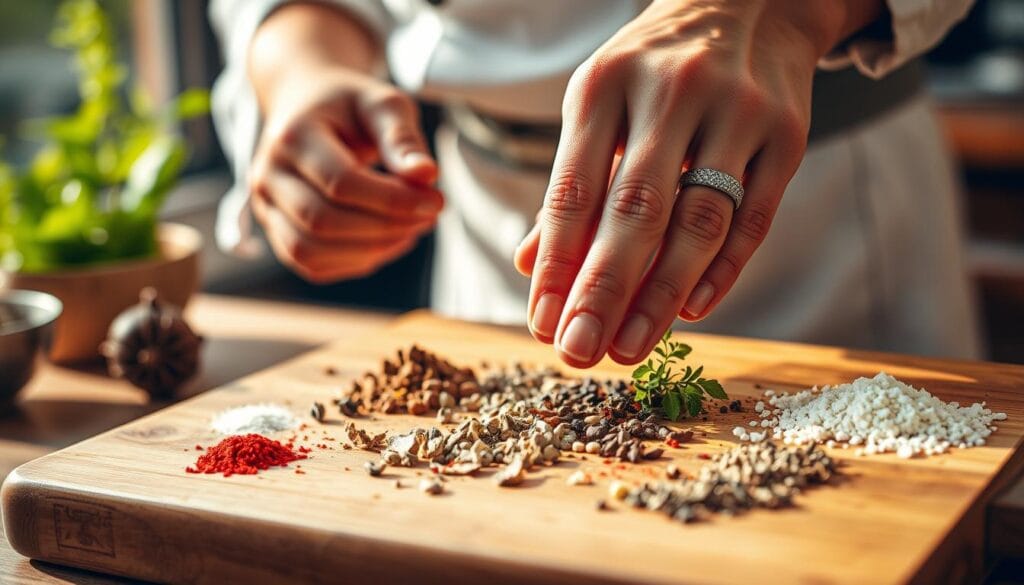Imagine creating a restaurant-style dinner right in your own kitchen. You can do it with minimal effort and incredible flavor. This one-pan wonder is ready in just 30 minutes, making it perfect for a busy weeknight.

You will love how this dish simplifies your cooking process. It delivers impressive results that taste like you spent hours preparing it. The beauty lies in its accessibility. You likely have most of the ingredients in your pantry already.
This recipe combines tender, juicy chicken breast with perfectly cooked pasta. They are enveloped in a rich, velvety garlic parmesan sauce. The combination of aromatic garlic, nutty parmesan, and cream creates a sauce so delicious. Every bite feels like a warm, comforting hug.
Whether you’re cooking for your family or preparing a meal for guests, this versatile dish adapts beautifully. It’s a fantastic choice for any occasion. We will walk you through each step with clear guidance. You will achieve perfect results, even if you are new to cooking from scratch.
Introduction to a Delicious One-Pan Meal
In the hustle of American life, a truly satisfying dinner that comes together quickly is a treasure. This is where the magic of a one-pan meal truly shines. You get a complete, flavorful dish with a fraction of the effort and cleanup.
What Makes This Recipe a Weeknight Favorite
You deserve a dinner solution that doesn’t compromise on taste when time is short. This recipe earns its favorite status by delivering maximum satisfaction in about 30 minutes. The one-pan method is a game-changer.
It eliminates the juggling act of multiple pots. This significantly cuts down your cleanup time after a long day. You are left with a meal that feels both indulgent and practical.
| Common Challenge | This Recipe’s Solution | Your Benefit |
|---|---|---|
| Long prep and cook time | Ready in roughly 30 minutes | More free time for you and your family |
| Complex cleanup | One-pan cooking method | Quick and easy washing up |
| Lack of flavorful options | Rich, restaurant-worthy sauce | A delicious meal everyone will love |
The Comfort Food Appeal for U.S. Diners
The appeal of this dish resonates deeply with many across the U.S. It offers the rich, satisfying experience of Italian-American restaurant classics. These familiar flavors create a nostalgic feeling that brings families together.
You will find that this parmesan chicken pasta recipe strikes a perfect balance. It is special enough for a date night yet simple enough for a Tuesday. American home cooks love how it delivers impressive results without advanced skills.
Ingredients Breakdown for Creamy Garlic Parmesan Chicken Pasta
The foundation of any great recipe starts with quality, accessible ingredients. You’ll find most of these items already in your kitchen or at any local grocery store.
For the Chicken and Seasonings
Begin with boneless, skinless chicken breasts. You’ll want to butterfly or pound them to about ½-inch thickness. This ensures even cooking and tender results.
Season your protein with Italian seasoning, paprika, salt, and pepper. These simple spices create a flavorful base. Use avocado oil or olive oil for searing—both work beautifully.
For the Pasta and Creamy Sauce
Choose penne or fusilli for this dish. They hold the sauce perfectly. You’ll cook them directly in chicken broth instead of water.
This infuses every strand with savory depth. The sauce comes together with unsalted butter, fresh garlic cloves, and heavy cream.
Use freshly grated parmesan cheese for the smoothest melt. Add fresh parsley at the end for a bright, colorful finish. For dairy-free options, full-fat coconut milk works wonderfully.
Step-by-Step Preparation Guide
Let’s walk through each stage together to create a perfectly balanced dish. These clear instructions will guide you to success, even if you’re new to one-pan cooking. You’ll gain confidence with each simple step.
Prepping and Seasoning the Chicken
Start by preparing your protein. Butterfly or pound the breasts to an even ½-inch thickness. This ensures uniform cooking.
Combine Italian seasoning, paprika, salt, and pepper in a small bowl. Pat the meat dry before rubbing the mixture on both sides. This creates a flavorful foundation.
Heat your large pan over medium heat with a tablespoon of oil. Cook the seasoned protein for 3-5 minutes per side. It’s done when the internal temperature reaches 165°F.
Remove the cooked meat from the pan and set it aside to rest. This allows the juices to redistribute for maximum tenderness.
Cooking Pasta in Flavorful Broth
Reduce the heat to medium-low. Add butter and a bit more oil to the same pan. Sauté diced onion with salt for about 3 minutes until translucent.
Add minced garlic and cook for just one minute until fragrant. Deglaze with 2 cups of chicken broth, scraping up the delicious browned bits.
Bring the broth to a light boil. Add your dry pasta and stir to submerge. Cover and cook for 10 minutes until al dente.
Turn off the heat. Stir in the cheese, heavy cream, and fresh parsley until the sauce thickens beautifully. Slice the rested meat and combine everything.
| Traditional Method | One-Pan Technique | Your Advantage |
|---|---|---|
| Multiple pots and pans | Single pan used throughout | Faster cleanup and less mess |
| Separate sauce preparation | Sauce develops in the same pan | Deeper, integrated flavors |
| Complex timing coordination | Sequential, simple steps | Reduced stress and easier execution |
Mastering One-Pan Cooking Techniques
Elevating your one-pan skills means focusing on two essential elements: choosing the right cookware and managing temperature. These fundamentals transform complex recipes into manageable weeknight successes.

Selecting the Right Pan
Your choice of cookware makes all the difference. A large stainless steel skillet with a lid works best for this recipe. This material gives you that beautiful golden sear you want.
Here’s a simple test to know when your pan is ready. Drop a bit of water on the surface. If it sizzles and evaporates immediately, wait longer. If it forms bubbles that dance across the surface, you’re good to go.
Always preheat your pan for several minutes before adding oil. This prevents sticking and ensures perfect browning every time.
Managing Heat Levels for Perfect Results
Heat control is your secret weapon. Start with medium heat for searing your protein. This develops that crispy, golden crust without burning.
Reduce to medium-low when sautéing aromatics like onions. This gentle heat brings out their sweetness without scorching.
Finally, maintain a light boil when cooking your noodles in broth. This ensures even cooking throughout your dish. Mastering these temperature adjustments builds incredible flavor layers in one vessel.
Understanding these techniques gives you confidence to tackle this recipe and many others. You’ll create restaurant-quality meals with ease.
Perfecting the Searing of Chicken
Achieving that perfect golden crust might seem challenging, but with these simple steps, you’ll get it right every time. This technique transforms your main ingredient into something truly special.
The process begins before your protein even touches the surface. Proper preparation sets the stage for success.
Achieving a Golden, Juicy Sear
Start by ensuring your cooking surface is properly preheated. This prevents sticking and creates that beautiful caramelization. You’ll know it’s ready when a drop of water dances across the surface.
Pat your main ingredient completely dry with paper towels. Moisture is the enemy of a good sear. Season both sides generously with your spice blend.
When you place the seasoned pieces in the hot pan with oil, listen for that immediate sizzle. This sound tells you everything is working correctly. Resist moving them for 3-5 minutes per side.
The pieces will naturally release when ready to flip. If they’re sticking, they need more time. Cook until the internal temperature reaches 165°F for safety and juiciness.
After cooking, let your perfectly seared protein rest before slicing. This allows juices to redistribute throughout. You’ll notice how the flavorful crust complements your final dish beautifully.
Creating a Luscious Garlic Parmesan Sauce
The heart of this comforting dish lies in its rich, velvety coating. This step transforms your ingredients into a cohesive masterpiece. You’ll build confidence with each simple technique.

Begin by turning off the heat before adding dairy. This prevents curdling and ensures a smooth texture. Add your heavy cream gradually while stirring continuously.
The secret to restaurant-quality sauce is patience and proper temperature control.
Thickening the Sauce to Perfection
Incorporate finely grated cheese using the smallest holes on your grater. Freshly grated cheese melts more smoothly than pre-shredded varieties. Watch as it creates a luxurious consistency.
For additional thickening, some cooks use a flour slurry. Mix two tablespoons of flour with two tablespoons of water. This gives you control over the final texture.
| Method | Process | Best For |
|---|---|---|
| Cheese Only | Stir in grated parmesan off heat | Quick, simple thickening |
| Flour Slurry | Mix flour and water before adding | Controlled, consistent results |
| Reduction | Simmer gently to evaporate liquid | Intense, concentrated flavor |
Balancing Flavors for a Creamy Finish
Taste and adjust seasoning gradually. The garlic should complement without overwhelming. Add salt and pepper until the flavor profile feels balanced.
If your sauce becomes too thick, use reserved pasta water to thin it. This also helps the coating cling better to your noodles. The final result should have a glossy, appealing appearance.
You can add fresh spinach at this stage for extra nutrition. It wilts quickly into the warm mixture. This creates a beautiful pop of color in your finished dish.
Exploring Variations for Dietary Needs
Adapting favorite recipes to meet different dietary needs has never been more accessible. You can easily modify this comforting dish to accommodate various preferences while maintaining its delicious character.
Whether you’re cooking for gluten-free or dairy-free guests, these simple swaps ensure everyone enjoys the meal. The key is choosing alternatives that work well with the cooking method.
Gluten-Free Pasta Alternatives
Switching to gluten-free noodles is straightforward. Brands like Banza offer excellent options with added protein benefits.
Always check package instructions since cooking times often differ. If your alternative cooks faster than 10 minutes, adjust the timing to prevent mushiness.
Dairy-Free Substitutes and Adjustments
For dairy-free versions, replace butter with vegan alternatives or extra oil. Plant-based creams like Country Crock work beautifully for that rich texture.
Full-fat coconut milk adds a subtle sweetness that complements the savory elements. The cheese component can be omitted or replaced with vegan options, though melting may vary.
These modifications let you create inclusive meals that work for various diets. You might also explore other dietary-friendly recipes for more inspiration.
Expert Tips for Enhancing Flavor and Texture
Small adjustments in your technique can transform your final dish from good to truly memorable. These professional secrets build layers of taste and perfect consistency that will impress your family and guests.

You’ll notice immediate improvement by applying these restaurant-quality methods. They require minimal extra effort but deliver maximum impact on your cooking results.
Proper Seasoning and Spice Application
Begin by seasoning your protein generously on both sides before cooking. This creates a flavorful foundation that carries through the entire recipe.
Remember to season at each stage of preparation. The initial spice blend on the main ingredient, then the aromatics as they cook, and finally adjusting the finished sauce.
Cooking your noodles to al dente ensures perfect texture. Using broth instead of water infuses deeper flavor into every strand.
Using Finely Grated Parmesan for the Best Melt
The quality of your cheese makes a significant difference in sauce texture. Freshly grated varieties melt much more smoothly than pre-shredded options.
Use the smallest holes on your grater for the finest shreds. This allows the cheese to incorporate seamlessly into your sauce without clumping.
Always add dairy products after turning off the heat. This prevents curdling and ensures a silky smooth consistency in your final creation.
Managing Leftovers and Reheating Techniques
Proper leftover management transforms your cooking efforts into convenient future meals. You’ll appreciate how this approach maximizes your time in the kitchen.
You’ll be delighted to discover this meal makes excellent leftovers. Cooking your noodles to al dente ensures they maintain perfect texture when reheated.
Storage Solutions to Maintain Freshness
Begin by letting your creation cool completely before storage. This prevents condensation that could make your meal soggy.
Transfer everything to an airtight container for refrigeration. Your dish will stay fresh for 3-4 days when stored properly.
The flavors actually develop more depth overnight. Your second serving might taste even better than the first.
| Storage Method | Duration | Reheating Instructions |
|---|---|---|
| Refrigerator (Airtight) | 3-4 days | Stovetop: Low heat with splash of milk |
| Microwave Safe | 3-4 days | Microwave: 1-2 minutes, stir halfway |
| Freezer (Not Recommended) | Avoid freezing | Sauce may separate upon thawing |
When reheating, use gentle heat to restore the sauce’s texture. A small splash of milk helps recreate the original creaminess.
This versatile meal also tastes wonderful served cold. It makes a fantastic packed lunch or quick snack option.
Final Reflections and Enjoying Your Meal
Your journey to mastering this delicious meal concludes with a sense of accomplishment and joy. You have created a restaurant-worthy dinner right at home. This recipe proves that incredible flavor doesn’t require hours in the kitchen.
As you sit down, notice how the rich sauce coats every strand perfectly. The tender protein and al dente noodles create a harmonious bite. For a complete meal, serve it with a simple side salad or some crusty bread.
This dish is a true crowd-pleaser, earning high praise from home cooks. It’s perfect for both busy weeknights and special gatherings. You can explore other fantastic one-pan ideas, like this garlic parmesan pasta recipe, for more inspiration.
Remember, cooking is about creating wonderful experiences. You’ve gained skills to make many more satisfying meals. Celebrate your success and enjoy every delicious bite!
